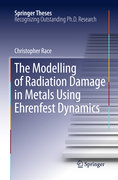
The modelling of radiation damage in metals usingehrenfest dynamics
Race, Christopher Peter
Atomistic simulations of metals under irradiation are indispensable for understanding damage processes at time- and length-scales beyond the reach of experiment. Previously, such simulations have largely ignored the effect of electronic excitations on the atomic dynamics, even though energy exchange between atoms and electrons can have significant effects on the extent and nature of radiation damage. This thesis presents the results of time-dependent tight-binding simulations of radiation damage, in which the evolution of a coupled system of energetic classical ions and quantum mechanical electrons is correctly described. The effects of electronic excitations in collision cascades and ion channeling are explored and a new model is presented, which makes possible the accurate reproduction of non-adiabatic electronic forces in large-scale classical molecular dynamics simulations of metals. INDICE: Introduction.- A Radiation Damage Cascade.- Electronic Excitationsin Radiation Damage – a Review.- Theoretical Background.- Simulating Radiation Damage in Metals. A Framework for Simulating Radiation Damage in Metals.- The Single Oscillating Ion.- Semi-calssical Simulations of Collision Cascades.- The Nature of the Electronic Excitations.- The Electronic Forces.- ChannellingIons.- The Electronic Drag Force.-Concluding Remarks.- A. Selected Proofs.- B. Petrubation Theory.- C. The coupling Matrix for a Single Oscillating Ion.- D. Some Features of the Electronic Excitation Spectrum.- E. The Strain on an Inclusion due to Electronic Heating.- Bibliography.- Index.
- ISBN: 978-3-642-15438-6
- Editorial: Springer
- Encuadernacion: Cartoné
- Páginas: 350
- Fecha Publicación: 01/11/2010
- Nº Volúmenes: 1
- Idioma: Inglés
